China’s humanoid robotics sector is rapidly transitioning from laboratory curiosity to commercial powerhouse, with new projections indicating the domestic China robot market will surge beyond 8 billion yuan ($1.15 billion USD) by 2025, capturing half of the global market. This seismic shift, detailed in the landmark 2025 Humanoid Robotics and Embodied Intelligence Industry Research Report unveiled at the recent Second China Humanoid Robotics and Embodied Intelligence Industry Conference, signals the dawn of a major new industrial era where China robot leadership is increasingly central.

The comprehensive report, collaboratively released by LiDe Robot, the Zhongguancun Zhiyou Research Institute, and eight other prominent institutions, forecasts that domestic humanoid robot production will exceed 10,000 units in 2025, achieving a market valuation of 8.239 billion yuan. Simultaneously, China’s embodied intelligence market – the sophisticated AI systems enabling these robots to perceive and interact with the physical world – is projected to reach 5.295 billion yuan, representing 27.12% of the global total. This dual-track growth firmly establishes China robot development as a critical axis in the global technology landscape.
From Validation to Commercialization: The China Robot Tipping Point
2024 has proven pivotal. The report identifies a powerful confluence of factors driving unprecedented momentum: significant advancements in core technologies, aggressive expansion into diverse application scenarios, intensified policy backing, surging capital inflows, and enhanced international collaboration. This synergy is propelling the China robot industry, particularly humanoids, out of its “technical validation phase” and into a rapid transition towards “large-scale commercial deployment.”
Industry analysts drawing parallels with China’s meteoric rise in electric vehicles suggest humanoid robotics could follow a similar trajectory. “The next five years are crucial,” the report emphasizes. “As costs decrease significantly and the industrial ecosystem matures, the China robot sector, led by humanoids, has the potential to replicate the explosive growth path of new energy vehicles, emerging as a formidable new engine for the Chinese economy.” This transition hinges on leveraging China’s unparalleled domestic market scale and comprehensive manufacturing supply chain – foundational advantages for scaling China robot innovation.
Global Race Intensifies: Embodied Intelligence as the New Battleground
The report underscores that humanoid robotics and embodied intelligence represent the new frontier in global technological supremacy, with China positioning itself aggressively. Global embodied intelligence spending is forecast to reach 19.525 billion yuan in 2025, skyrocketing to an astonishing 232.63 billion yuan by 2030 – a compound annual growth rate (CAGR) of 64.18%. Automation and manufacturing are identified as the primary near-term drivers for embodied AI adoption, followed closely by accelerating deployment in healthcare and logistics.
Within this fierce global competition, the report outlines distinct strategic imperatives for China robot advancement. For humanoids, the path forward centers on “scenario-driven implementation,” underpinned by relentless technological breakthroughs and guided by disciplined capital investment. Success requires shifting from “lab innovation” to widespread adoption in both industrial settings (“factory”) and consumer environments (“home”). The embodied intelligence sector, meanwhile, must prioritize differentiated innovation and pragmatic application solutions in the short term, while strategically building towards universal humanoid platforms for long-term global leadership. The vision is clear: humanoid robots, as human-centric universal platforms, are poised to become the primary interface for future intelligent systems. Dominating this interface requires China robot technologies to become ubiquitous.
Securing Leadership: Challenges and the China Robot Roadmap
Achieving global dominance demands confronting critical challenges head-on. The report stresses that China must leverage its massive domestic market not just for scale, but as a crucible for rapid iteration and refinement. Overcoming core technological bottlenecks – especially in high-precision actuators, advanced sensors, and cutting-edge AI chips – is non-negotiable for achieving supply chain autonomy and resilience within the China robot ecosystem.
Furthermore, the battle for standard-setting power is paramount. The report advocates for aggressive pursuit of real-world deployments across diverse, demanding scenarios – manufacturing floors, complex logistics hubs, elder care facilities, and potentially hazardous environments. Success in these arenas will generate invaluable data, refine performance benchmarks, and crucially, allow Chinese enterprises to establish de facto technical standards for the global China robot market. This proactive approach in defining operational norms and safety protocols is essential for shifting from areas of “partial leadership” to comprehensive global dominance in humanoid robotics and embodied intelligence.
The message resonating from the conference is unambiguous: the China robot revolution, particularly in humanoids, is no longer speculative. It’s an industrial reality accelerating towards massive scale. With strategic focus on technological mastery, supply chain control, and real-world implementation to drive global standards, China is laying the groundwork to not just participate, but to lead the defining technological transformation of the coming decade. The race to build the robots of tomorrow is accelerating, and China robot development is positioned firmly at the forefront.
